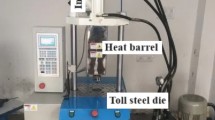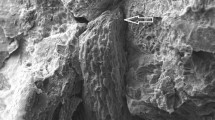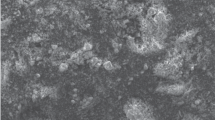Abstract
Generally, fillers are added in thermoplastic polymers to enhance their mechanical properties, reduces cost, and improve appearance of the composites. In this paper, high-density polyethylene (HDPE) was compounded with different waste fillers such as silica, kaolin, calcium carbonate, and fly ash with an aim to compare the composite performance and effects of different filler loading. Tensile test, impact test, burning test, and water absorption were used to characterize the HDPE composites. Results show that addition of fillers in HDPE improved the tensile modulus, reduced 14% of the burning rate, and increased water absorption over time, compared to unfilled HDPE. However, tensile strength, impact strength, and elongation at break reduced by 30–50%, 50%, and 98% compared to the neat HDPE, respectively. Addition of calcium carbonate in HDPE shows the best fire retardant, the highest tensile strength, and the longest elongation at break as compared to composites with silica, fly ash, and kaolin.










Similar content being viewed by others
References
Akindoyo JO et al (2020) Simultaneous impact modified and chain extended glass fiber reinforced poly (lactic acid) composites: mechanical, thermal, crystallization, and dynamic mechanical performance. J Appl Polym Sci 138(5):49752
Akindoyo JO, Ismail NH, Mariatti M (2019) Performance of poly(vinyl alcohol) nanocomposite reinforced with hybrid TEMPO mediated cellulose-graphene filler. Polym Test 80:106140
Beg MDH et al (2018) Characterization of polyamide 6.10 composites incorporated with microcrystalline cellulose fiber: Effects of fiber loading and impact modifier. Adv Polym Technol 37(8):3412–3420
Orue A et al (2016) The effect of alkaline and silane treatments on mechanical properties and breakage of sisal fibers and poly(lactic acid)/sisal fiber composites. Compos Part A Appl Sci Manuf 84:186–195
Essabir H et al (2017) A comparison between bio- and mineral calcium carbonate on the properties of polypropylene composites. Constr Build Mater 134:549–555
Akindoyo JO et al (2018) Impact modified PLA-hydroxyapatite composites–thermo-mechanical properties. Compos Part A Appl Sci Manuf 107:326–333
Akindoyo JO et al (2019) Oxidative induction and performance of oil palm fiber reinforced polypropylene composites—effects of coupling agent and UV stabilizer. Compos Part A Appl Sci Manuf 125:105577
López OV et al (2018) Processing–properties–applications relationship of nanocomposites based on thermoplastic corn starch and talc. Polym Compos 39(4):1331–1338
Passaretti MG et al (2019) Biocomposites based on thermoplastic starch and granite sand quarry waste. J Renew Mater 7(4):393–402
Kamerling S, Schlarb AK (2018) Enhancing polymer based tribocompounds using mineral fillers with an energy absorbing material transformation. In Proceedings of Asia International Conference on Tribology 2018. Malaysian Tribology Society
Sormunen P, Kärki T (2019) Compression molded thermoplastic composites entirely made of recycled materials. Sustainability 11(3):631
Yi M et al (2016) Flexible fiber-reinforced composites with improved interfacial adhesion by mussel-inspired polydopamine and poly(methyl methacrylate) coating. Mater Sci Eng C 58:742–749
Yao Z et al (2014) Mechanical and thermal properties of polypropylene (PP) composites filled with CaCO3 and shell waste derived bio-fillers. Fibers Polym 15(6):1278–1287
Väisänen T et al (2016) Utilization of agricultural and forest industry waste and residues in natural fiber-polymer composites: a review. Waste Manag 54:62–73
Shamsuri AA, Sumadin ZA (2018) Influence of hydrophobic and hydrophilic mineral fillers on processing, tensile and impact properties of LDPE/KCF biocomposites. Compos Commun 9:65–69
Tanniru M, Misra R (2005) On enhanced impact strength of calcium carbonate-reinforced high-density polyethylene composites. Mater Sci Eng A 405(1–2):178–193
Tarade RS, Mahanwar PA (2019) Mechanical Thermal and morphologicalproperties of recycled and virgin PC/wollastonite composite and its compatibilization by SBC. J Mater Environ Sci 10:357–366
Mittal P et al (2019) Polypropylene composites reinforced with hybrid inorganic fillers: morphological, mechanical, and rheological properties. J Thermoplast Compos Mater 32(6):848–864
Baioumy MGS et al (2019) Surface-treated kaolin minerals as a complement or substitute to glass fibers in thermoplastics. Polym Eng Sci 59(S1):E330–E338
Sarikanat M et al (2019) The effect of various minerals on sound transmission loss and mechanical properties of polypropylene. Acta Phys Pol, A 135(5):1055–1057
Rothon R (1999) Mineral fillers in thermoplastics: filler manufacture and characterisation. Springer, Berlin, pp 67–107
Ahmed T, Mamat O (2011) The development and characterization of HDPE-silica sand nanoparticles composites. In: 2011 IEEE Colloquium on Humanities, Science and Engineering. IEEE
Lazzeri A et al (2005) Filler toughening of plastics. Part 1—The effect of surface interactions on physico-mechanical properties and rheological behaviour of ultrafine CaCO3/HDPE nanocomposites. Polym 46(3):827–844
Ahmad I, Mahanwar PA (2010) Mechanical properties of fly ash filled high density polyethylene. J Min Mater Charact Eng 9(03):183
D’Amato M et al (2012) High performance polyethylene nanocomposite fibers. Exp Polym Lett 6(12):954–964
Sewda K, Maiti S (2013) Dynamic mechanical properties of high density polyethylene and teak wood flour composites. Polym Bull 70(10):2657–2674
Christensen K, Pedersen G, Kristensen H (2001) Preparation of redispersible dry emulsions by spray drying. Int J Pharm 212(2):187–194
Ivanić M et al (2015) Mineralogy, surface properties and electrokinetic behaviour of kaolin clays from the naturally occurring pegmatite deposits. Geol Croati 68(2):139–145
Wong M et al (2004) Study of surface damage of polypropylene under progressive loading. J Mater Sci 39(10):3293–3308
Schrauwen BAG (2003) Deformation and failure of semicrystalline polymer systems: influence of micro and molecular structure. PhD Thesis, Eindhoven University of Technology, Eindhoven, The Netherlands, ISBN-90-386-2914-1
Mazidi MM, Aghjeh MR, Abbasi F (2012) Relationship between microscopic deformations and macroscopic mechanical response of SAN/PB-g-SAN blends via interparticle distance concept. J Polym Res 19(8):9928
Shebani A et al (2018) The Influence of LDPE Content on the Mechanical Properties of HDPE/LDPE Blends. Res Dev Mater Sci 7(5):791–797
Siddique S et al (2019) Structural and thermal degradation behaviour of reclaimed clay nano-reinforced low-density polyethylene nanocomposites. J Polym Res 26(6):154
Nurdina A, Mariatti M, Samayamutthirian P (2009) Effect of single-mineral filler and hybrid-mineral filler additives on the properties of polypropylene composites. J Vinyl Addit Technol 15(1):20–28
Thomas S, Zaikov GE (2008) Polymer nanocomposite research advances. Nova Publishers, New York
Wypych G (2010) Handbook of fillers, 4th edn. Chem Tec Publishing, Toronto
Shebani A et al (2016) Effects of Libyan kaolin clay on the impact strength properties of high density polyethylene/clay nanocomposites. Int J Compos Mater 6(5):152–158
Muthuraj R et al (2016) Influence of processing parameters on the impact strength of biocomposites: A statistical approach. Compos Part A Appl Sci Manuf 83:120–129
Fu S-Y et al (2008) Effects of particle size, particle/matrix interface adhesion and particle loading on mechanical properties of particulate–polymer composites. Compos Part B Eng 39(6):933–961
Fairuz A et al (2016) Effect of filler loading on mechanical properties of pultruded kenaf fibre reinforced vinyl ester composites. J Mech Eng Sci 10(1):1931–1942
DeArmitt C (2011) 26 - Functional Fillers for Plastics. In: Kutz M (ed) Applied Plastics Engineering Handbook. William Andrew Publishing, Oxford, pp 455–468
Dong Y, Jow J, S-y Lai Fly Ash based Fillers and Flame Retardants
Depeng L et al (2018) Synergistic effects of intumescent flame retardant and nano-CaCO3 on foamability and flame-retardant property of polypropylene composites foams. J Cell Plast 54(3):615–631
Jancar J et al (1999) Mineral fillers in thermoplastics I: raw materials and processing. Springer, Berlin
Mustafa SN (2012) Effect of kaolin on the mechanical properties of polypropylene/polyethylene composite material. Diyala J Eng Sci 5(2):162–178
Daramola OO (2019) Flexural properties and water absorption characteristics of high density polyethylene-based siloceous composites. Acta Technica Corviniensis-Bull Eng 12(3):57–62
Acknowledgements
We are very grateful to the Malaysian Ministry of Education for awarding us a Fundamental Research Grant (MRSA with grant no. 6071284) and Universiti Sains, Malaysia, that made this study possible.
Author information
Authors and Affiliations
Corresponding author
Additional information
Publisher's Note
Springer Nature remains neutral with regard to jurisdictional claims in published maps and institutional affiliations.
Rights and permissions
About this article
Cite this article
Rasib, S.Z.M., Mariatti, M. & Atay, H.Y. Effect of waste fillers addition on properties of high-density polyethylene composites: mechanical properties, burning rate, and water absorption. Polym. Bull. 78, 6777–6795 (2021). https://doi.org/10.1007/s00289-020-03454-3
Received:
Revised:
Accepted:
Published:
Issue Date:
DOI: https://doi.org/10.1007/s00289-020-03454-3




